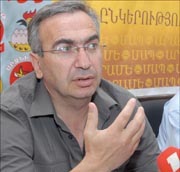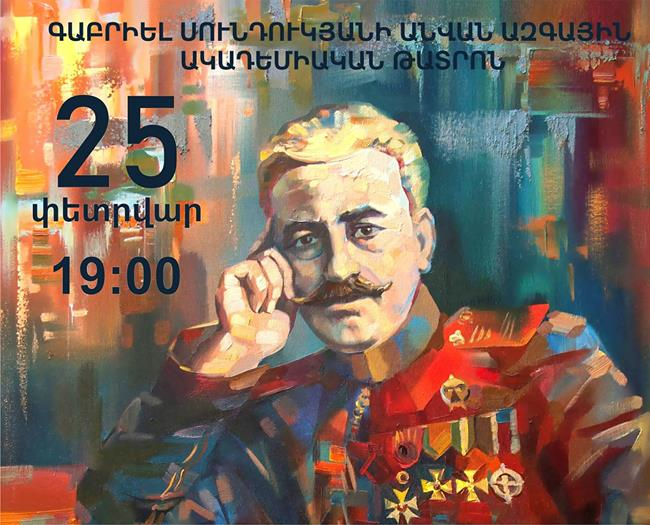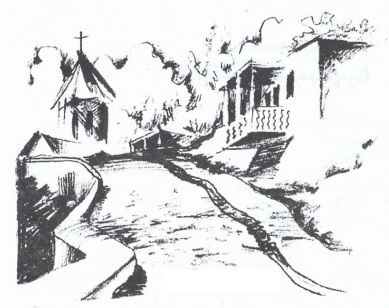 Various traditional dances would have been forgotten if Gagik Ginosyan, a highly-merited person devoted to national choreography, didn’t sacrifice his time and love for the sake of restoring them. Up to now dances of different provinces of Greater Hayk have been collected, arranged and staged.
Various traditional dances would have been forgotten if Gagik Ginosyan, a highly-merited person devoted to national choreography, didn’t sacrifice his time and love for the sake of restoring them. Up to now dances of different provinces of Greater Hayk have been collected, arranged and staged.
Interview by Elize Hovhannisyan
19.07.2012
“Mr. Ginosyan, as a rule people learn dancing from childhood. Nevertheless, you’ve managed to break this stereotype and mastered the first basic elements of Armenian dance when you were adult.. How did you enter the sphere of choreography?”
“My friend was in love with a girl, who danced Hayrik Muradyan’s group. He decided to take dance courses in order to meet the girl more frequently. By that time I was an adult and he asked me to accompany him. This request sounded a bit strange for me. I didn’t want to refuse my friend and accepted the request, though I realized that I could not be included among dancers. For the first time I danced in the presence of foreign people before being recruited. Whatever. Hayrik Muradyan, who taught me to dance, to sing and to be an Armenian, lifted me to the stage. Two months later my friend married the girl, and I devoted my life to choreography.”
“What implication does dance have for you? Is it a branch of art or something different?”
“The most difficult way is the one that leads you into your own self. Dance makes me wealthy and leads me into the way of self-purification. Komitas said: “Things that one can’t teach to children during five lessons can be mastered through a single dance.” Dance is an art that brings both the body and soul into harmony. It is difficult to find another better means for influencing someone, shaping him, sowing a national characteristic, nourishing him from national sources and thus multiplying the Armenian race.”
“The carried out activities don’t allow Armenian national dance to perish. What is the reason you decided to return to national sources?”
“I’ve never diverged from my sources. I’ve been brought up in a family, where the members secretly listened to songs dedicated to Andranik Pasha. If you fail to preserve what you have, it will be extremely hard to create something new. Generally, everything is created thanks to hard and laborious work in a long period of time, but it takes an instant to ruin everything, like earthquakes and hurricanes do.”
“Unfortunately, our culture underwent earthquakes and hurricanes. Which is the way of regaining a prosperous culture?”
“We need to have architects and workers. In order to return to out national sources we need to revise the value system set in our country and, secondly, we need to bring up a new generation of intellectuals. A few high-rank officials say that currently there are no intellectuals among us, but they are mistaken. Jivani said: “Great people stand far away and allow the ignoramus people to appear in the public, see those half-wits.” Today TV ether and positions are given to the feebles, and this fact considerably eases the problem of governing and deteriorates country’s state of affairs. Returning to sources assumes an incessant restoration works. It takes a week to know and to understand, and a week to realize the idea. It is useless to hope that we will succeed in restoring the lost national elements. We need to make strenuous efforts.”
“Mr. Ginosyan, you travel throughout Armenia and collect the last pieces of Armenian dances that have come to us thanks to people, who have danced and preserved them. This is an individual work.”
“I’ve recently been in the USA and met tender-hearted people, who were eager to preserve Armenian national culture. There is a great number of materials that they collected from Diaspora Armenians. Sometimes Armenians residing abroad are more inclined to preserving national culture. The difference between Karin members and choreographers residing in the USA is that we stage the restored dances, while they use it as a scientific material. Restoring dances is not an easy task: it requires professional experience, attention, prudence, skill for finding important details, etc. Finding a dance is only the first step. If dance has to serve as a solely scientific material, it will rather turn into a dusty book in a bookshelf, than become a culture.”
“What steps need to be taken not to let Armenian national dance perish from the minds of Armenians residing in different corners of the world? Isn’t it too late to act?”
“It is necessary to find cooperation terms with them, and the first steps are already done. With regards to choreography in Armenia, it is certainly late, because currently there are few people, who have preserved dances performed by their ancestors. There are a number of cases when we visited a settlement hoping to meet with aged people and collect still preserved dance samples… Unfortunately we were late and got there only to take part in their funerals or at least in the mourning ceremonies. At the best, we can say that only 30 percent of dances have been restored. If we were the contemporaries of Komitas Vardapet, the chances of collecting the greater part of Armenian dances would be higher. Nevertheless, collecting dances today is similar to playing a jigsaw. We try to guess how it really looked like by joining the dance elements together. We can’t think about completely restoring dances that we had 3-5 thousand years before. Restoration that we carry out today is a quite belated work; like archaeologists we try to excavate in many cases extinct culture, which had long ago been covered with a clay layer.”
“No efforts have been made before to preserve national dances, have they? We have ethnographical literature.”
“The main written source is Srbuhi Lisitsyan’s works. She collected the greatest number of Armenian dances starting from the late 1940’s and created a kinetography, a system for recording dance movements. We have restored a number of dances basing on her records. Besides, we are looking and finding other records in books: they are also useful for restoration works. We come across similar materials in the literary works of Perch Proshyan and Ghevond Alishan. Some dances, however, can’t be staged using the mentioned method. One should feel the dance. The sequence of movements cannot be considered a dance. It is important to feel the spirit, the energy and the inner motion of a dance. It should keep the audience alive, the latter will not go through the dance if it doesn’t excite him and doesn’t give him the spirit and the mood of war, happiness or wedding.”
“Mr. Ginosyan, currently songs and dances are being rearranged with great excitement and as a result undergo certain changes, while you are trying to restore the old. Do you thing this process makes the culture more popular, or it leads the old culture to destruction?”
“Today a number of “singers” take Kochari melody and use it as a middle movement in their songs. This mergings are completely meaningless in the sense of connotation, concept and melody. Five thousand years on Kochari has been a dance shaping men, it is impermissible for representatives of unknown sex to do queer movements under the melody. Cultural treasures should be protected on a state level. For example, why should unknown crooners sing Armenian national anthem? Maybe they will perform Lord’s Prayer as well? There are sacred treasures that need to be protected on a state level and be used and rearranged by the permission of certain committees only. I hope that my words are sobering, though they may sound acute. In the book “The Struggle of Sons against Fathers” Garegin Nzhdeh wrote that “there are times in the history, when the bringing up generation and the one that is being brought up are replaced; it is possible that servility has left an incurable mark among elders. If you are not the generation willing to save Armenia, then the only road of your country is the one that leads to destruction.” We think that we preserve our culture but, I think, culture preserves us. Mashtots, Shnorhali, Narekatsi, Komitas, Nzhdeh… These names are the expressing the genius of our country.
Armenia is an economically developing country. Culture is like a snowball rolling down to an abyss; day by day it becomes bigger and bigger and gathers speed on the way to the bottom of the abyss. Unless it hasn’t reached the bottom and it is still possible to stop the decline of our culture, we should regain consciousness, otherwise twenty or twenty five years later it would be impossible to regain national values.”
“Hayatsk” Daily
Issue 141 (308), December 14, 2012
http://www.hayatsk.am/5284.html


